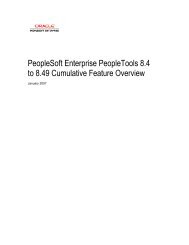COGNOS Business Intelligence Series 7
pes.pdf
pes.pdf
You also want an ePaper? Increase the reach of your titles
YUMPU automatically turns print PDFs into web optimized ePapers that Google loves.
Appendix A: Context Help<br />
If most incoming requests are similar in duration, choose this algorithm to minimize time and<br />
CPU cycles.<br />
• A value of 0 means each request is submitted to the process with the shortest queue.<br />
If incoming requests vary in duration, choose this algorithm for better performance.<br />
• A value from 1 to 9 means each request is submitted to the process with the best queuing<br />
percentage.<br />
This algorithm polls each server process to determine the processing time taken for the current<br />
request and the amount of time queued requests have been waiting. The queuing percentage is<br />
calculated as wait time/process time for the current request, expressed as a percentage. The<br />
incoming request is then directed to the first process whose queuing percentage is less than 10<br />
times the threshold value. For example, a scheduling threshold value of 5 means that the<br />
request is passed to the first process whose queuing percentage is less than 50%.<br />
Under heavy load conditions, this algorithm is the most effective. It reduces wait time, but at<br />
the cost of lower overall throughput. To use this algorithm effectively, decrease its value to<br />
reduce the number of processes polled before one is selected.<br />
Local Process Threshold<br />
Sets the threshold at which requests are queued to be processed locally rather than forwarded to a<br />
mirror reference.<br />
When both a source and a mirror reference exist for a cube or report, the server chooses local<br />
(source) processing. If no local processes are available, requests can be queued up to the threshold<br />
set (provided the Maximum Processes limit has been reached).<br />
The default setting of 0 means requests are never queued. They are immediately forwarded to the<br />
mirror reference.<br />
Read Cache Size (mb)<br />
Sets the amount of disc space used for the read cache for the cube. If your system has sufficient<br />
resources, increasing the read cache size may improve performance.<br />
The default value is 0, which sets the read cache size to use the default server settings. The default<br />
server settings are 8mb for Windows, and 16mb for UNIX.<br />
Publishing<br />
Publish to a Table of Contents<br />
Lists the cube or report for Web users in the Table of Contents.<br />
By default, all data is published. You may want to prevent some cubes or reports from being listed<br />
in the Table of Contents. For example, some cubes can be made available only for drill-through<br />
access from another cube, or, some reports may be added for testing purposes.<br />
Note: You can also disable the entire Table of Contents (p. 53).<br />
Publish to Portal<br />
Lists the cube or report for Web users in the portal (Upfront or Cognos Connection).<br />
Upfront Server Group<br />
Specifies the name of the Upfront server group (Upfront Server Group by default). The name is<br />
retrieved from the server configuration file when you connect to a server in the PowerPlay<br />
Enterprise - Server Administration tool.<br />
The Upfront Server group specifies a URL to the Upfront gateway program such as<br />
http://portal/cognos/cgi-bin/upfcgi.exe.<br />
It also specifies a list of server name and port number combinations available to handle publishing<br />
requests. The gateway program communicates with the first server in the list, the primary<br />
processor. If this server should become unavailable, the gateway program communicates with the<br />
next server in the list, providing continuous service.<br />
Enterprise Server Guide 89
















